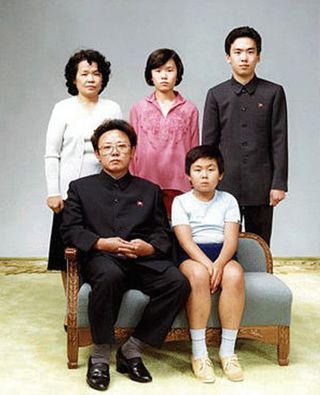
The assassination of Kim Jong-nam, the half brother of North Korean leader Kim Jong-un, keeps getting stranger.
Soon after having his face rubbed with a cloth by two women at the airport in Kuala Lumpur, Malaysia, the exiled North Korean complained of facial pain, had a seizure and died.
Malaysian police have now revealed that Kim Jong-nam was killed with a poison called VX nerve agent. But what exactly is this agent, and how does it kill?
Deadly weapon
It turns out that VX, which is a shortened form of "Venomous Agent X," is one of the deadliest chemical weapons in the world and is banned under the Chemical Weapons Conventions of 1997 and 2005. The tasteless, odorless, viscous, motor-oil-like liquid kills by causing uncontrollable muscle spasms that eventually stop the heart, according to the Centers for Disease Control and Prevention. It is more potent than sarin gas. [5 Lethal Chemical Warfare Agents]
VX, which was discovered in the 1950s by a British chemist, belongs to a family of chemicals known as organophosphates, which are widely used as pesticides. The nerve agent can be administered as a gas or as a liquid. Symptoms from gas exposure occur within seconds, and systems from liquid exposure happen within minutes to hours, according to the CDC. Just 10 milligrams of the liquid applied to the skin is enough to cause death, according to the Federation of American Scientists. Although people can recover from mild exposure, a severe exposure is typically deadly, according to the CDC.
VX works by binding to and inactivating an enzyme that turns off the nerve-signaling molecule acetylcholine, according to the Organisation for the Prohibition of Chemical Weapons (OPCW). Acetylcholine works throughout the body to activate muscles.
When someone is exposed to VX nerve agent, the acetylcholine that is freely circulating in synapses never gets taken out of circulation and continually binds to receptors throughout the body. Initially, this causes uncontrollable muscle spasms. Over time, these muscles become fatigued and stop working, leading the heart to stop beating, according to the OPCW. Excessive active acetylcholine in the brain leads to seizures, said Patrick Forcelli, an assistant professor of pharmacology at Georgetown University Medical Center.
Sign up for the Live Science daily newsletter now
Get the world’s most fascinating discoveries delivered straight to your inbox.
Acetylcholine is also a major signaling molecule in the parasympathetic, or involuntary, nervous system, Forcelli told Live Science. Too much acetylcholine causes victims to have pinpoint-size pupils, digestive problems, and excess salivation and tears, he added.
VX has been used in the past, most notably in attacks by the Japanese cult Aum Shinrikyo. Hiroyuki Nagaoka, whose son was part of the cult, experienced some of these symptoms when cult members attacked him with VX in Japan in 1995, according to the Associated Press. Nagaoka reported that a cult member sprayed the agent on the back of his neck, but his coat collar blocked most of it.
Within 30 minutes, Nagaoka's pupils shrank, and he started feeling hot inside and sweating excessively. "His wife later told him that he got down on all fours, like an animal, twisting and scratching his neck and chest, before rolling onto his back in pain and losing consciousness," the AP reported.
Now, more than 20 years after the attack, Nagaoka said he still has numbness on his body's right side and uses an oxygen tube to help him breath, according to the AP.
Possible treatments
If Kim Jong-nam knew what had been rubbed on his face, he could have limited his exposure by flushing the skin with soap and water to remove as much of the liquid as possible, according to the CDC. He could also have received an antidote known as atropine, which essentially blocks the acetylcholine receptors, preventing the overstimulation, and eventual degradation in function, of these receptors, according to the OPCW. Another antidote, called pralidoxime, reactivates the enzyme that takes acetylcholine out of circulation, but it must be given soon after exposure to counteract VX's deadly effects. There are also antidotes that can be taken as a precaution by soldiers anticipating exposure to nerve agents, but those require advance knowledge of possible exposure, according to the OPCW.
In a post on the website The Poisons Garden, poisons expert John Robertson speculated that the women who rubbed a cloth on Kim Jong-nam's face and sprayed something on it were using two different compounds that chemically reacted on Kim Jong-nam's face to form VX. That would explain why the women themselves could easily handle the material without dying. (One of the women did subsequently require treatment.)
Although the United States and other superpowers once had large stockpiles of VX nerve agent, the U.S. began destroying its stores in the late 1960s, when it canceled its chemical weapons program in 1969. North Korea, which is not a party to the conventions, may have somewhere between 2,500 and 5,000 tons (2,300 to 4,500 metric tons) of the deadly agent, The New York Times reported.
Live Science senior writer Laura Geggel contributed to this report.
Originally published on Live Science.

Tia is the managing editor and was previously a senior writer for Live Science. Her work has appeared in Scientific American, Wired.com and other outlets. She holds a master's degree in bioengineering from the University of Washington, a graduate certificate in science writing from UC Santa Cruz and a bachelor's degree in mechanical engineering from the University of Texas at Austin. Tia was part of a team at the Milwaukee Journal Sentinel that published the Empty Cradles series on preterm births, which won multiple awards, including the 2012 Casey Medal for Meritorious Journalism.

